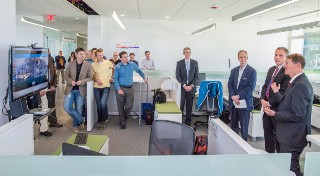Apr 30 2015
The U.S. Department of Energy today announced $75 million in funding to renew the Joint Center for Artificial Photosynthesis (JCAP), a DOE Energy Innovation Hub originally established in 2010 with the goal of harnessing solar energy for the production of fuel.
 DOE Under Secretary for Science and Energy Lynn Orr (rt.) announces the renewal of JCAP’s funding while visiting the JCAP facility at Berkeley Lab April 27.
DOE Under Secretary for Science and Energy Lynn Orr (rt.) announces the renewal of JCAP’s funding while visiting the JCAP facility at Berkeley Lab April 27.
JCAP researchers are focused on achieving the major scientific breakthroughs needed to produce liquid transportation fuels from a combination of sunlight, water, and carbon dioxide, using artificial photosynthesis.
While the scientific challenges of producing such fuels are considerable, JCAP will capitalize on state-of-the-art capabilities developed during its initial five years of research, including sophisticated characterization tools and unique automated high-throughput experimentation that can quickly make and screen large libraries of materials to identify components for artificial photosynthesis systems.
“Basic scientific research supported by the Department of Energy is crucial to providing the foundation for innovative technologies and later-stage research to reduce carbon emissions and combat climate change,” said Under Secretary for Science and Energy Lynn Orr. “JCAP’s work to produce fuels from sunlight and carbon dioxide holds the promise of a potentially revolutionary technology that would put America on the path to a low-carbon economy.”
JCAP – which brings together many of the world’s top researchers in the field of artificial photosynthesis – is led by the California Institute of Technology in partnership with Lawrence Berkeley National Laboratory, and operates research sites at both institutions. A Southern California site is located at the Caltech campus in Pasadena, while a Northern California site operates at Lawrence Berkeley National Laboratory in Berkeley. Additional partners include SLAC National Accelerator Laboratory; the University of California, Irvine; and the University of California, San Diego.
JCAP is one of several Energy Innovation Hubs established by the Department of Energy beginning in 2010. The Energy Innovation Hubs are major integrated research centers, drawing together researchers from multiple institutions and varied technical backgrounds. They are modeled after the strong scientific management approaches typified by the Manhattan Project, the Lincoln Lab at MIT, which developed radar, AT&T’s Bell Laboratories, which developed the transistor, as well as the successful DOE Bioenergy Research Centers established during the Bush Administration to pioneer advanced techniques in biotechnology, including biofuels.
Under the renewal plan, the five-year-old center would receive funding for an additional five years of research, subject to congressional appropriations.